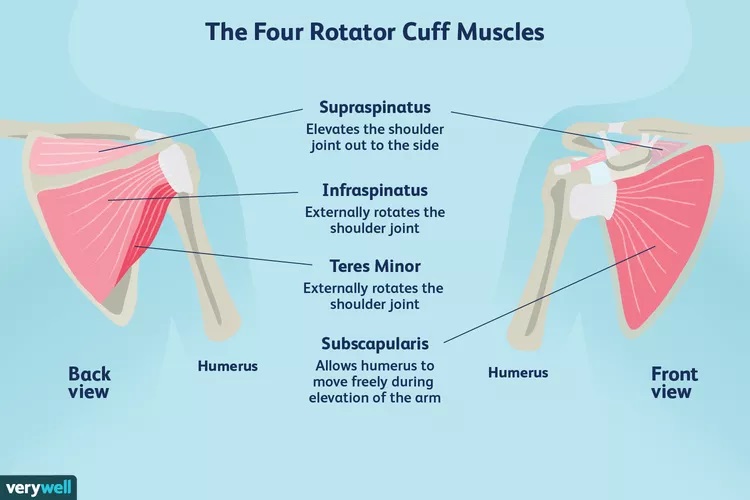| Rotator Cuff |
The Anatomy and Function Of Rotator Cuff Muscles

Your rotator cuff is made up of four muscles: the supraspinatus, infraspinatus, teres minor, and subscapularis.
The muscles start on the scapula and join as tendons to form a thick covering at the top of the humerus (the bone in the upper arm).
The rotator cuff has several important jobs, including stabilizing the shoulder, elevating and rotating the arm, and ensuring the head of the humerus stays securely placed in the shoulder socket.
Anatomy
The four muscles of the rotator cuff are:
• Supraspinatus: The supraspinatus muscle originates above the spine of the shoulder blade and inserts on the greater tuberosity of the humerus.
• Infraspinatus: The infraspinatus muscle originates below the spine of the scapula in the infraspinatus fossa. It inserts on the posterior aspect of the greater tuberosity (the part of the bone that attaches to the corresponding muscle) of the humerus.
• Teres minör: The teres minor muscle originates on the lateral scapula border and inserts on the inferior aspect of the greater tuberosity of the humerus.
• Subscapularis:The subscapularis muscle originates on the anterior, or front surface, of the scapula, sitting directly over the ribs, and inserts on the lesser tuberosity of the humerus. Subcapularis is the main internal rotator of the shoulder.It is largest & strongest cuff muscle, providing %53 of total cuff strength.
Function
Each rotator cuff muscle performs a specific, important job that helps your shoulder joint work.
Your rotator cuff:
• Stabilizes the head of the humerus in the shoulder joint. The supraspinatus, infraspinatus, teres minor, and subscapularis muscles all work together to keep the joint stable.
• Abducts (elevates) the shoulder joint out to the side. These motions are done by the supraspinatus.
• Externally rotates the shoulder joint. The infraspinatus and teres minor muscles are responsible for these movements.
• Internal rotates the shoulder joint. The subcapularis muscle is the main internal rotator of the shoulder.
• Depresses the head of the humerus. The subscapularis muscle does this to allow the humerus to move freely in the shoulder joint when the arm is raised.
***All four rotator cuff muscles work together to centralize your humerus bone in the shoulder joint. When you lift your arm, your rotator cuff muscles pull the joint together to stabilize your shoulder.
Since these muscles are so involved in the movement and stabilization of the shoulder, they can get worn out and even tear if the arm is used a lot or if it is injured in some way.
| SLAP (Superior Labrum Anterior Tear) |

When cartilage in the shoulder's inner joint capsule is torn, a SLAP tear occurs. Tears can be caused by accident or overuse, and can make it unpleasant or difficult to move your shoulder and arm. If left untreated, these tears can cause chronic pain, impair arm and shoulder mobility, and lead to more severe shoulder problems.Three causes contribute to SLAP tears:
Chronic damage. Over time, SLAP rips can occur in athletes and exercisers who perform a great deal of overhead motion. Baseball and softball, swimming, and weightlifting are common causes of SLAP tears. Chronic trauma is the leading cause of SLAP tears.
Acute injury. SLAP tears can occur if you try to block a fall with an outstretched arm or if you lift heavy objects with sudden jerking movements.
Aging. Labrum degeneration might result in SLAP tears over time. This tear is typically observed in individuals aged 40 and older.
Symptoms
Common SLAP tear symptoms include:
1. Shoulder pain that can be a persistent dull ache or a sharp pain deep in your shoulder.
2. Shoulder pain in certain positions, like raising your arm or stretching your arm behind your head.
3. Shoulder pain when you do certain things, like throwing a ball or reaching overhead.
4. Popping noises or a grinding feeling when you move your shoulder.
5. A feeling like your shoulder might pop out of your shoulder blade.
| Subacromial Impingement Syndrome (SIS) |
.jpg)
Subacromial Impingement Syndrome (SIS) is a condition that arises from compression or friction between the supraspinatus tendon and the bursa (subacromial bursa) and the acromion, a bone in the shoulder. This condition manifests itself with pain, strain, and limited mobility during lifting movements of the shoulder.
Scientifically, SIS is defined as a pathology resulting from the narrowing of the subacromial space or abnormal positioning of anatomical structures. The subacromial space, where the supraspinatus tendon and bursa reside, is typically limited. Repetitive shoulder movements or abnormal shoulder anatomy can increase this narrowing, putting pressure on the tendon and bursa.
Symptoms include shoulder pain, particularly increased pain during lifting movements, loss of strength, and limited range of motion in the shoulder. Diagnosis is typically based on physical examination, imaging tests (e.g., MRI), and clinical history.
Treatment generally involves conservative methods, including rest, physiotherapy, pain management, and shoulder strengthening exercises. However, if conservative treatment is not effective or the condition is severe, surgical intervention may be considered. Surgery may involve correcting anatomical structures causing compression and releasing tissues.
Scientifically, SIS is defined as a pathology resulting from the narrowing of the subacromial space or abnormal positioning of anatomical structures. The subacromial space, where the supraspinatus tendon and bursa reside, is typically limited. Repetitive shoulder movements or abnormal shoulder anatomy can increase this narrowing, putting pressure on the tendon and bursa.
Symptoms include shoulder pain, particularly increased pain during lifting movements, loss of strength, and limited range of motion in the shoulder. Diagnosis is typically based on physical examination, imaging tests (e.g., MRI), and clinical history.
Treatment generally involves conservative methods, including rest, physiotherapy, pain management, and shoulder strengthening exercises. However, if conservative treatment is not effective or the condition is severe, surgical intervention may be considered. Surgery may involve correcting anatomical structures causing compression and releasing tissues.